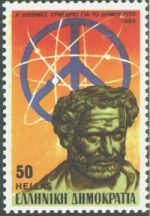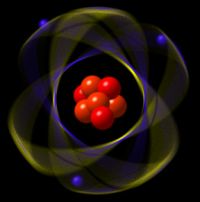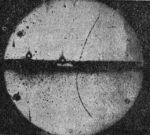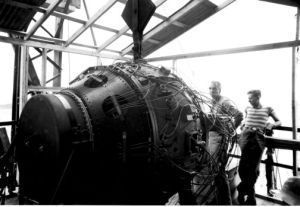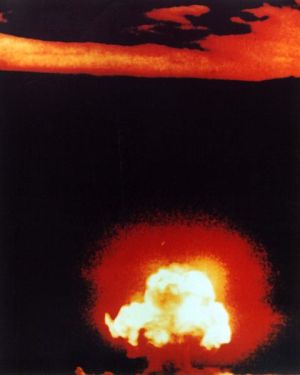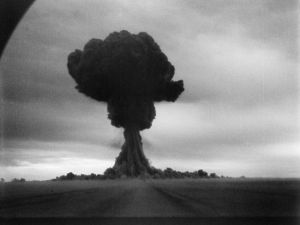Atom Timeline: I. Rise of the Nuclear Age
I. Rise of the Nuclear Age
II. From Hiroshima and Nagasaki
to the Cold War
III. The Industrial Atom:
Nuclear Energetics and the Cold War
|
Wilhelm Roentgen, while conducting experiments with cathode rays, accidentally discovers of a new and different kind of ray. These rays were so mysterious that Roentgen named them ’x-rays’. He received the first Nobel Prize in Physics in 1901 for this discovery. http://en.wikipedia.org/wiki/Wilhelm_R%C3%B6ntgen | Radioactivity was discovered in 1896 by the French scientist Henri Becquerel while working on phosphorescent materials. At first it seemed that the new radiation was similar to the then recently discovered X-rays. However further research by Becquerel, Marie Curie, Pierre Curie, Ernest Rutherford and others discovered that radioactivity was significantly more complicated. Different types of decay can occur. For instance, it was found that an electric or magnetic field could split such emissions into three beams. For lack of better terms, the rays were given the alphabetic names alpha, beta, and gamma, names they still hold today. It was immediately obvious from the direction of electromagnetic forces that alpha rays carried a positive charge, beta rays carried a negative charge, and gamma rays were neutral. http://en.wikipedia.org/wiki/Radioactivity | The electron as a unit of charge in electrochemistry was posited by G. Johnstone Stoney in 1874, who also coined usage of "electron" in 1894. During the late 1890s a number of physicists posited that electricity could be conceived of as being made of discrete units, which were given a variety of names, but their reality had not been confirmed in a compelling way.The discovery that the electron was a subatomic particle was made in 1897 by J.J. Thomson at the Cavendish Laboratory at Cambridge University, while he was studying "cathode rays". Influenced by the work of James Clerk Maxwell, and the discovery of the X-ray, he deduced that cathode rays existed and were negatively charged "particles", which he called "corpuscles." He published his discovery in 1897. He received the Nobel Prize in Physics in 1906 for this discovery. http://www.atomicarchive.com/Timeline/Ti... | In experimental particle physics, a particle detector is a device used to track and identify high-energy particles, such as produced by nuclear decay, cosmic radiation, or reactions in a particle accelerator. Detectors designed for modern accelerators are huge, both in size and in cost. The notion counter is often used instead of detector, when the detector counts the particles but does not resolve its energy or ionization. Particle detectors usually can also track ionizing radiation (high energy photons or even visible light). If their main purpose is radiation measurement, they are called radiation detector, but as photons can also be seen as (massless) particles, the term particle detector is still correct. http://en.wikipedia.org/wiki/Particle_Detectors |
|
The proton was discovered after Rutherford noticed that when alpha particles were shot into nitrogen gas, his scintillation detectors showed the signatures of hydrogen nuclei. Rutherford determined that the only place this hydrogen could have come from was the nitrogen, and therefore nitrogen must contain hydrogen nuclei. He thus suggested that the hydrogen nucleus, which was known to have an atomic number of 1, was an elementary particle. http://en.wikipedia.org/wiki/Proton |
|
A particle accelerator is a device that uses electric and/or magnetic fields to propel electrically charged particles to high speeds. The first one was built in 1929 by Ernest O. Lawrence. http://en.wikipedia.org/wiki/Particle_ac... | James Chadwick suggested that a new radiation, discovered by Walther Bothe and H. Becker in Germany, consisted of uncharged particles of approximately the mass of the proton, and he performed a series of experiments verifying his suggestion. Such uncharged particles were eventually called neutrons, apparently from the Latin root for neutral and the Greek ending -on (by imitation of electron and proton). http://en.wikipedia.org/wiki/Neutron#Discovery |
|
In 1932 the physicist James Chadwick in England performed a series of experiments showing that a newly discovered radiation thought to be gamma rays was untenable. He suggested that in fact the new radiation consisted of uncharged particles of approximately the mass of the proton, and he performed a series of experiments verifying his suggestion. Such uncharged particles were eventually called neutrons, apparently from the Latin root for neutral and the Greek ending -on (by imitation of electron and proton). http://www.nuclearfiles.org/menu/library... | Enrico Fermi irradiates uranium with neutrons. He believes he has produced the first transuranic element, but unknowingly achieves the world’s first nuclear fission. http://www.nuclearfiles.org/menu/timelin... | Leo Szilard wrote a letter on August 2nd 1939, where he expressed his fears for Nazi Germany acquiring nuclear weapons, which Einstein agreed to sign as his own. http://www.dannen.com/ae-fdr.html |
|
The Russian Research Centre Kurchatov Institute, the first state national research Center of Russia, was set up in place of the I.V.Kurchatov Institute of Atomic Energy (former Laboratory No.2 of the USSR Academy of Sciences founded in 1943) in November 1991 in accordance with the Decree of President of Russia. The Centre is directlz governed bz the Russian Government and does not belong to either the Russian Academy of Sciences or any branch ministry. http://www.kiae.ru/eng/wel/all/dp1.htm |
|
|
The Laboratory No 2 branch was established with the aim of designing and manufacturing a nuclear device per se. At the time it was also known as Design Bureau No 1, Privolzhskaya Kontora (’The Volga Office’), ’KB-11,’Installation No. 558,’Kremlev,’Moscow, Center 300,’ and ’Arzamas-75’. The exceptional secrecy surrounded the program. Later on it became the All-Union (now - All-Russian) Scientific-Research Institute of Experimental Physics (VNIIEF), widely known by the latest coded name of its location as Arzamas-16. the town reappeared under its origianla name of Sarov after the collapse of the Soviet Union. http://www.nato.int/acad/fellow/94-96/su... | |||||||
| 5th cent. BC |------------------------------------------------------------- |
1895 --|---------------------------------------------------------- |
1896 ---|--------------------------------------------------------- |
1897 ---|--------------------------------------------------------- |
1900 -----|------------------------------------------------------- |
1911 -----------|------------------------------------------------- |
1918 ---------------|--------------------------------------------- |
1927 --------------------|---------------------------------------- |
1929 ---------------------|--------------------------------------- |
1932 -----------------------|------------------------------------- |
1932 -----------------------|------------------------------------- |
1932 -----------------------|------------------------------------- |
1934 ------------------------|------------------------------------ |
1939 ---------------------------|--------------------------------- |
1942 ----------------------------|-------------------------------- |
1943 -----------------------------|------------------------------- |
1945-7-16 ------------------------------|------------------------------ |
1949-8-1 --------------------------------|---------------------------- |
1956-2-1 ------------------------------------|------------------------ |
I. Rise of the Nuclear Age
II. From Hiroshima and Nagasaki
to the Cold War
III. The Industrial Atom:
Nuclear Energetics and the Cold War
Compiled and edited by
Andreas Andersson
Sergey Glushakov
